Pickleball Injuries: Staying Healthy and Safe on the Court
Pickleball has rapidly gained popularity as a sport that blends elements of tennis, badminton, and table tennis. Its appeal lies not only in its accessibility requiring minimal equipment and space but also in its social nature that promotes community and shared enjoyment. However, like any sport, pickleball carries the risk of injury, particularly for older adults and those new to the game. Understanding the common injuries associated with pickleball and the various prevention strategies is vital for ensuring a safe and enjoyable experience on the court. This article delves into the types of injuries players may encounter, their symptoms, diagnosis, prevention methods, and the potential long-term impacts of these injuries.
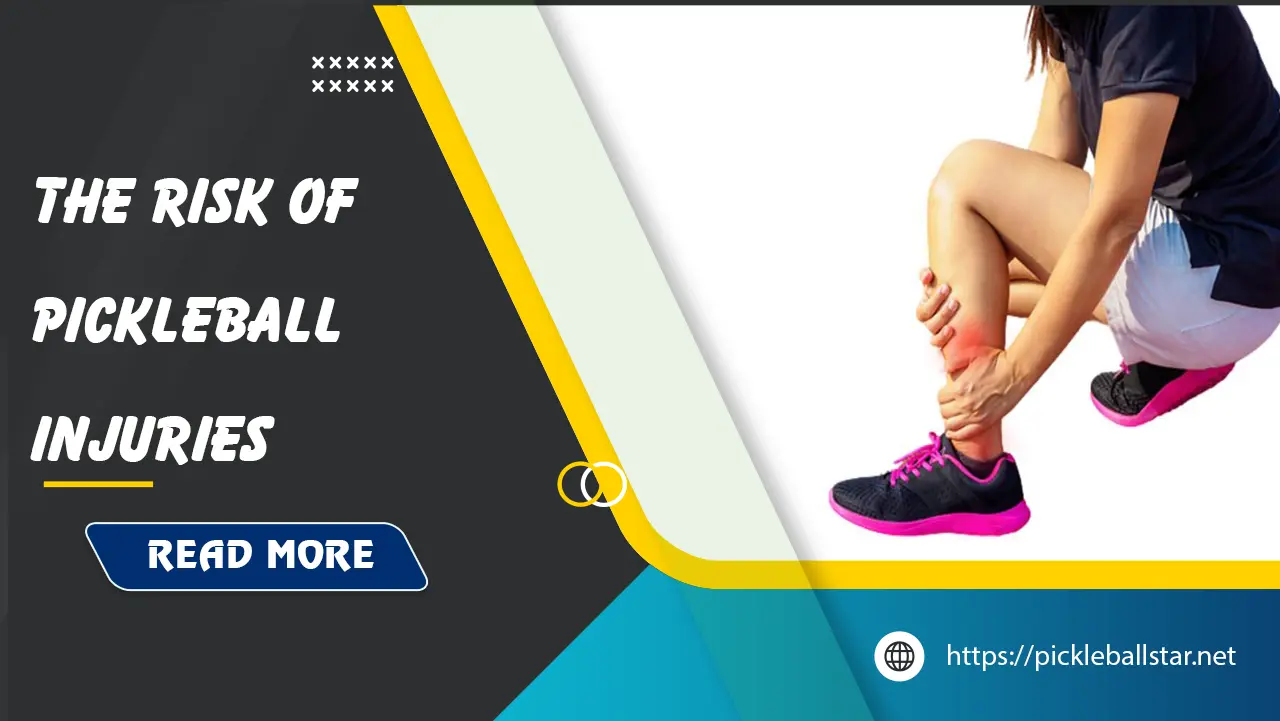
One of the most common concerns players face is the prevalence of injuries stemming from both the physical demands of the game and improper technique. With the rapid increases in participation rates among older adults, particularly those over 50, recognizing the nature of these injuries has become paramount. Consider the game of pickleball as a delicate dance; it requires balance, agility, and precision. Yet, when fatigue sets in or technique falters, even the most graceful of dancers can stumble. In this light, we will explore the various types of injuries that may arise, starting from the basic categories to specific examples, so players can better understand how to maintain their joy in this fast-paced sport.
Types of Injuries
Injuries in pickleball typically arise due to overuse, improper technique, or inevitable accidents during play. As the sport involves numerous repeated motions and quick directional changes, various parts of the body can be susceptible to injury, including the shoulders, elbows, wrists, knees, ankles, and feet. Let’s delve deeper into these categories to understand their nuances.
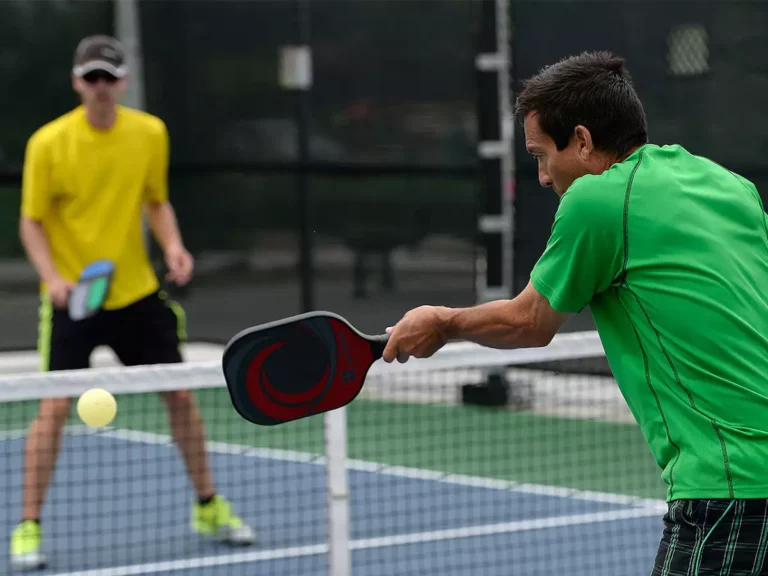
- Shoulder Injuries: The shoulder joint bears the brunt of swinging motions, making it vulnerable to strains and tears. Common injuries include rotator cuff tears, shoulder dislocations, and tendinitis.
- Elbow Injuries: Known colloquially as “pickleball elbow,” lateral and medial epicondylitis are common ailments stemming from repetitive gripping and swinging, leading to inflammation around the elbow joint.
- Wrist Injuries: The wrist experiences significant strain during play, leading to sprains or tendonitis if not properly managed. Mismanagement of wrist mechanics can amplify these risks.
- Knee and Ankle Injuries: Often resulting from sudden pivots and landings, knee sprains and ankle injuries, particularly sprains, are prevalent among players. The meniscus and ligament in the knee, as well as the ligaments around the ankle, can suffer significant strain.
- Foot Injuries: These injuries may range from blisters to structural issues like plantar fasciitis, all of which can cause discomfort and limit mobility on the court.
By understanding these injury types, players can remain vigilant and take necessary precautions to avoid them during gameplay. Let’s take a closer look at specific common injuries, beginning with shoulder injuries, followed by elbow and wrist injuries, knee and ankle injuries, and, finally, foot injuries, on how to identify, mitigate, and potentially resolve these common pickleball-related injuries.
Shoulder Injuries
Shoulder injuries in pickleball often stem from the repetitive actions of serving and volleying. They represent a significant portion of the ailments experienced by players, particularly due to the nature of the sport which involves frequent overhead motions. The dynamics of a pickleball match can resemble a meticulously choreographed ballet, where every swing and serve requires a harmonious blend of strength and flexibility. However, just as a dancer can experience fatigue that leads to missteps, so too can a pickleball player suffer injuries when the shoulder undergoes excessive strain or improper use.
Common Shoulder Injuries:
- Rotator Cuff Tear: The rotator cuff is a collection of muscles and tendons that stabilize the shoulder, allowing a wide range of motion. Overuse from repetitive swinging can lead to partial or full-thickness tears, resulting in pain and weakness.
- Shoulder Dislocation: A dislocation occurs when the ball-and-socket joint is forced out of its normal position, often as a result of a sudden fall or impact. This can lead to intense and immediate pain, often accompanied by swelling and loss of mobility.
- AC Joint Separation: The acromioclavicular (AC) joint can experience injury through falls directly onto the shoulder. This injury can range from mild (stretching of the ligaments) to severe (complete dislocation) and is typically characterized by pain at the top of the shoulder.
- Fractures: Fractures can occur in the clavicle or upper arm bone, particularly following falls onto an outstretched arm. This type of injury can be quite debilitating, often leading to severe pain, swelling, and significant limitations in movement.
- Frozen Shoulder: Known medically as adhesive capsulitis, this condition can develop following an injury or period of inactivity. It results in stiffness and severe restriction of movement and can be exacerbated by the lack of mobility following a shoulder injury.
Prevention Strategies
To minimize the risk of shoulder injuries, players should engage in proper warm-up routines, utilize lightweight paddles, and practice correct swinging techniques. Additionally, incorporating strength and flexibility training, along with adequate rest, can greatly reduce the likelihood of developing chronic shoulder issues. Recognizing early symptoms such as pain or discomfort during play enables players to seek appropriate treatment, be it rest, rehabilitation exercises, or professional medical advice, to mitigate further damage.
Elbow Injuries
Elbow injuries are another prevalent concern among pickleball players, typically arising from the repetitive motions associated with gripping the paddle and executing various strokes. Picture the elbow as an intricate gear in the machinery of a dynamic game; when it operates smoothly, the game flows effortlessly. But when strain accumulates, the performance falters, leading to pain and possibly significant injury.
Common Elbow Injuries:
- Pickleball Elbow (Lateral Epicondylitis): Similar to tennis elbow, this condition involves inflammation of the tendons around the elbow due to repetitive motion. Symptoms include pain on the outer elbow and difficulty with wrist movements.
- Medial Epicondylitis: Often referred to as golfer’s elbow, this injury affects the tendons on the inner elbow and is frequently linked to similar repetitive movements seen in pickleball strokes. Pain and weakness may manifest, particularly during gripping activities.
- Tendonitis: Tendonitis can arise due to overuse in the elbow area affecting both lateral and medial tendons, resulting in chronic pain that may escalate if not properly managed.
Prevention Strategies
Players must prioritize proper technique and form to mitigate their risks for elbow injuries. This includes using the correct grip, ensuring adequate breaks during play to avoid fatigue, and maintaining a balanced fitness regimen that strengthens the forearm and elbow areas. Regularly engaging in wrist and forearm stretching and strengthening exercises can also provide important injury repulsion. Players experiencing symptoms should assess their techniques and consider consulting a physical therapist for tailored recommendations.
Wrist Injuries
Wrist injuries represent a common category for pickleball participants. As with elbow injuries, similar repetitive motions undertaken during gameplay can lead to various forms of wrist strain. The wrist often bears the consequences of awkward falls or gripping the paddle too tightly. Visualize the wrist as the cornerstone of movement; its stability is vital. However, when that stability is compromised, the entire structure can suffer.
Common Wrist Injuries:
- Wrist Sprains: Sprains occur when ligaments in the wrist get stretched or torn, often resulting from falls or awkward landings. Symptoms include pain, swelling, and bruising.
- Wrist Discomfort: General wrist discomfort can arise from poor technique, particularly relating to gripping the paddle tightly. This discomfort can manifest as persistent aching, potentially leading to tendonitis.
- Tendonitis: Similar to elbow tendonitis, wrist tendonitis develops over time due to repeated stress on wrist tendons, typically resulting from gripping strokes. Pain during gripping or lifting the paddle is a typical indicator.
Prevention Strategies
Proper warm-up techniques targeting the wrist joint can greatly minimize the risk of injuries while playing. Practicing relaxation techniques while gripping the paddle is equally essential to reduce tension in the wrists. Moreover, utilizing wrist supports can provide added protection during gameplay and prevent undue strain, especially for players with a history of previous wrist injuries.
Knee Injuries
Knee injuries tend to be commonly encountered in pickleball, particularly due to the sport’s demands for sudden pivots and quick directional changes. Imagine the knee as the fulcrum a critical supporting element that helps players position themselves on the court. When subjected to unnatural movements, the knee can sustain immense strain, which can lead to debilitating injuries.
Common Knee Injuries:
- Knee Sprains: These involve stretching or tearing of the ligaments, often occurring during sudden directional changes. The severity ranges from mild to severe.
- Muscle Strains: Strains can affect the quadriceps and hamstring muscles around the knee due to overexertion or improper warm-up.
- Meniscal Injuries: The meniscus absorbs shock in the knee joint. Twisting movements can lead to tears, often presenting with pain and swelling.
- Patellar Tendonitis: Commonly referred to as “jumper’s knee,” this injury arises from repetitive stress on the knee, often manifesting as pain around the kneecap.
- Bursitis: This condition entails inflammation of the bursa and can arise from pressure on the knee joint, leading to swelling and stiffness.
Prevention Strategies
Players can mitigate the risk of knee injuries by incorporating regular strength training focusing on leg muscles and maintaining a proper stretching routine before and after gameplay. Proper movements during gameplay, including appropriate footwear designed for court sports, can enhance stability and support while reducing injury risk.
Ankle Injuries
Ankle injuries can cause significant distress to pickleball players, often occurring from rapid lateral movements or falls during play. Picture the ankle as the foundation of mobility; when compromised, the ability to engage effectively and efficiently on the court is diminished.
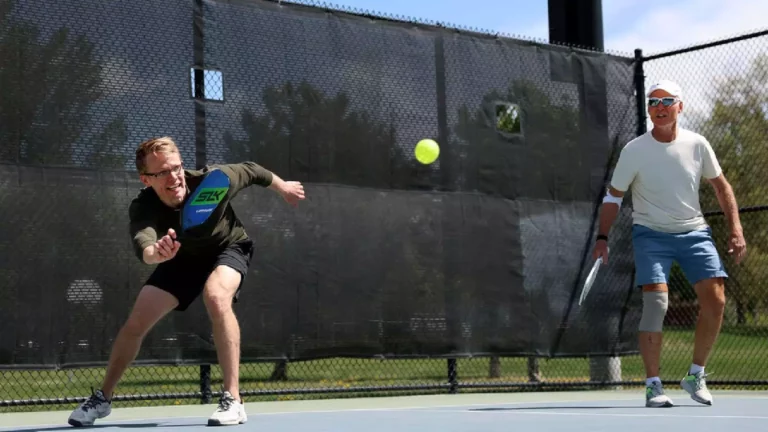
Common Ankle Injuries:
- Ankle Sprains: The most common type of ankle injury, these occur when ligaments are stretched or torn, typically during sudden lateral movements. Inversion and eversion sprains constitute the majority of these accidents.
- Achilles Tendon Injuries: The sudden movements required in pickleball can lead to tears or ruptures in the Achilles tendon, resulting in severe pain in the back of the ankle.
- Plantar Fasciitis: Overuse from jumping or rapid running in pickleball can contribute to plantar fasciitis, causing sharp pain in the heel area of the foot.
- Fractures: Less commonly, fractures in ankle bones can occur due to high-impact falls during play.
Prevention Strategies
Proper footwear is essential for minimizing ankle injuries, with shoes designed to provide ample support and traction to prevent rolling the ankle during dynamic movements. Warming up the ankles through mobility exercises and utilizing ankle guards can provide further protection against sprains and injuries.
Foot Injuries
Foot injuries frequently occur in pickleball, arising from the nature of the sport and the physical demands placed on the feet. The quick lateral movements, coupled with abrupt stops, can lead to a host of foot-related concerns. Think of the foot as the player’s primary tool; if it cannot function effectively, performance wanes.
Common Foot Injuries:
- Blisters: Common in many sports, blisters arise due to friction between the foot and footwear during play.
- Achilles Tendon Injuries: Similar factors affecting the ankles can lead to tendonitis or ruptures in the Achilles tendon.
- Sprains: Variations in foot landing can lead to sprains, particularly if the foot rolls inadvertently during play.
- Fractures: Though rarer, fractures of the midfoot bones can occur following falls or high-impact accidents.
- Plantar Fasciitis: This overuse injury is characterized by pain in the heel and is often exacerbated by activity on hard surfaces.
- Metatarsalgia: This involves inflammation and pain in the ball of the foot, often due to excessive stress or improper footwear.
Prevention Strategies
To minimize the likelihood of foot injuries, players should focus on wearing appropriate shoes that accommodate the quick footwork required during play. Proper warm-up and stretching routines can also enhance the foot’s resilience, allowing for better adaptability to the sport’s demands.
Symptoms and Diagnosis
Identifying the signs and symptoms of pickleball injuries is essential for timely and effective treatment. The indicators of injury may vary but typically include:
- Pain: Localized discomfort that worsens during movements or activity related to the injured area signifies trouble.
- Swelling and Inflammation: Visible swelling can be a vital indicator of underlying issues and should not be overlooked.
- Changes in Mobility: Reduced range of motion or difficulty in moving the affected joint or area can signify a serious condition requiring attention.
- Weakness: A noticeable decrease in strength, especially in the region of the injury, should not be ignored.
- Chronic Symptoms: Persistent pain indicative of overuse injuries can develop gradually and limit playing time if left unattended.
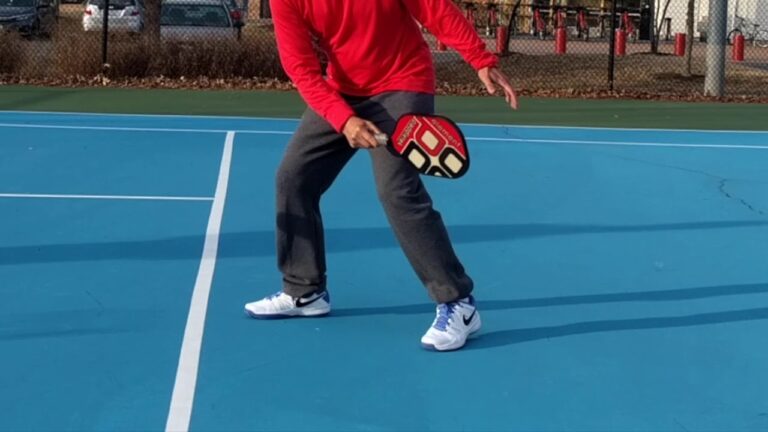
Diagnosis
Diagnosing injuries typically involves comprehensive assessments, including:
- Patient History: Gathering details about when, how, and where the injury occurred for context.
- Physical Examination: A thorough inspection of the affected area to assess swelling, tenderness, or bruising.
- Imaging Studies: Utilizing X-rays or MRI to identify structural issues, fractures, or soft tissue injuries.
- Functional Tests: Assessing how injuries affect movement or specific activities can assist in accurate diagnosis.
By recognizing the symptoms early and seeking appropriate evaluation, players can streamline their recovery and treatment process.
Pain Assessment Techniques
Understanding the intensity and source of pain associated with pickleball injuries is pivotal. Healthcare professionals employ various pain assessment techniques to gauge the severity and type of injury:
- Patient History: Collecting information about the timing, cause, and intensity of pain helps isolate the injury type.
- Physical Examination: A careful examination of the injured area to evaluate swelling, tenderness, and any mobility restrictions.
- Pain Scales: Using a numeric scale (1-10) allows patients to quantify pain intensity, aiding in effective diagnosis and treatment planning.
- Imaging Studies: Understanding the full extent of injuries through supportive imaging can reveal underlying concerns.
- Functional Tests: These assess the patient’s ability to perform specific movements, providing insight into how the injury may be impacting daily activities or gameplay.
Overall, the combination of these methods aids healthcare providers in forming accurate diagnoses and provides a roadmap for effective treatment and recovery.
Common Symptoms of Overuse Injuries
Overuse injuries are particularly relevant in pickleball, as the sport requires significant repetitive movement, often leading to chronic discomfort. Common symptoms include:
- Pain: Often localized, this pain may become worse with activity, such as swinging a paddle or executing a serve.
- Swelling and Inflammation: Localized swelling often accompanies pain in overuse injuries, suggesting an inflammatory response from the body.
- Stiffness: Reduced flexibility and increased stiffness in affected joints create challenges during gameplay.
- Weakness: Players may find a general weakness in the injured limb, leading to decreased performance and increased susceptibility to further injury.
- Reduced Performance: A decline in the ability to perform usual activities, including swinging or reaching, can indicate an overuse injury.
- Chronic Symptoms: Often gradual in onset, if not recognized early, overuse injuries can impede participation, necessitating longer recovery periods.
Understanding these symptoms enables players to seek timely medical assistance, allowing them to reclaim their enjoyment of the sport.
Diagnostic Imaging for Injuries
When injuries arise in pickleball, diagnostic imaging plays a significant role in evaluating the damage and forming appropriate treatment strategies. Common imaging techniques include:
- X-rays: Used primarily to identify fractures or structural issues, X-rays provide insight into the integrity of bones post-injury.
- MRI: With the capability of assessing soft tissue injuries, an MRI can help in the evaluation of tendons, ligaments, and cartilage damage.
- CT Scans: Although less commonly employed than X-rays or MRI for soft tissue injuries, CT scans can be utilized for a more comprehensive view of complex injuries.
- Ultrasound: Particularly useful for evaluating soft tissue injuries, ultrasound can assist in identifying swelling and other structural concerns.
Incorporating imaging studies into injury evaluation enables practitioners to tailor treatment comprehensively, enhancing recovery prospects and minimizing complications.
Risk Factors
Understanding the risk factors associated with pickleball injuries is crucial for prevention and management. Several key elements contribute to the likelihood of sustaining an injury while playing:
- Age-Related Considerations: Older adults are at higher risk for injuries due to natural physiological changes, such as decreased flexibility and bone density.
- Poor Technique and Form: Inadequate technique, such as gripping the paddle improperly or not utilizing proper body mechanics during gameplay, increases the likelihood of trauma on joints.
- Improper Equipment: Using inappropriate footwear or paddles may increase strain on body parts, leading to greater injury risk during play.
- Environmental Factors: Playing on unsafe or unsuitable surfaces may also contribute to accidents and injuries.
By identifying these risk factors, players can apply proactive measures to lessen the likelihood of injury, ensuring many enjoyable hours on the court.
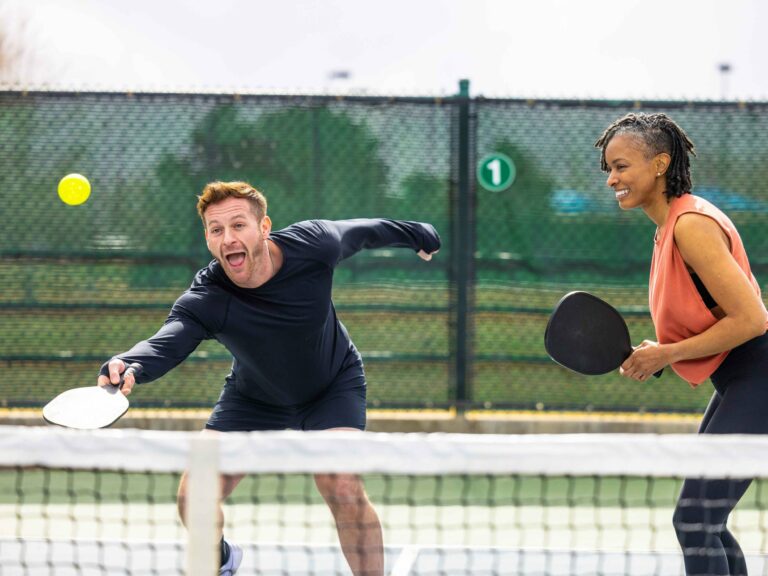
Age-Related Injury Risks
In pickleball, age-related injury risks are significant, particularly among older adults. Research has shown that approximately 87% of pickleball-related injuries requiring emergency treatment occur in individuals over 50 years of age. Several factors contribute to this increased vulnerability:
- Decreased Flexibility: With age, the body’s flexibility typically diminishes, increasing the risk of strains and sprains during quick movements.
- Lower Muscle Strength: As people age, muscle mass and strength often decline, reducing stability and control during play, leading to a higher risk of injuries.
- Pre-existing Conditions: Many older adults contend with chronic conditions such as arthritis or cardiovascular issues that may exacerbate injury risk during physical activities.
- Cardiac Events: The short, intense bursts of activity required during pickleball put older players at risk for heart-related incidents, including myocardial infarctions.
Understanding these age-related risks encourages players to adopt preventive practices that enhance their safety during games.
Poor Technique and Form
A significant risk factor for injury in pickleball lies in poor technique and form, which can lead to undue strain on joints and muscles. Bad habits acquired during play may result from various factors, including:
- Insufficient Training: Players lacking proper instruction may develop improper mechanics, increasing their chances of injuries like sprains, strains, and tendonitis.
- Inexperienced Players: Beginners may struggle to refine their skills and techniques, heightening susceptibility to injury from misdirected swings or forced movements.
- Fatigue: As players tire, their form may deteriorate, leading to incorrect movements that can cause injuries.
To mitigate these risks, players must prioritize foundational techniques through consistent practice, drills, and seeking professional instruction. Maintaining awareness of posture, movement patterns, and playing style can ensure a safer experience on the court.
Equipment-Related Risks
Equipment-related risks can significantly contribute to the likelihood of injuries during pickleball play. Consider this: the gear you choose can either enhance your playing experience or prove detrimental to your health. Some equipment-related factors influencing injury risk include:
- Improper Footwear: Shoes that do not provide sufficient support may lead to ankle sprains and falls, especially during quick lateral movements.
- Heavy or Incorrectly Sized Paddles: Paddles that are too heavy or of the wrong grip size can cause strain, especially if used by older players whose physical capabilities are not aligned with their equipment.
- Lack of Protective Gear: Players who do not utilize supportive gear such as ankle braces or wrist guards may face higher risks of sprains and fractures during play.
- Worn or Damaged Equipment: Regularly using damaged paddles or shoes can increase the risk of injuries due to reduced functionality or support.
Implementing proactive measures, such as selecting the right equipment and maintaining it regularly, can vastly improve player safety and performance on the court.
Prevention Strategies
Preventing injuries in pickleball requires implementing comprehensive strategies that merge warm-up exercises, selection of proper equipment, and improvement of techniques. By staying proactive, players can mitigate the risk of injury effectively.
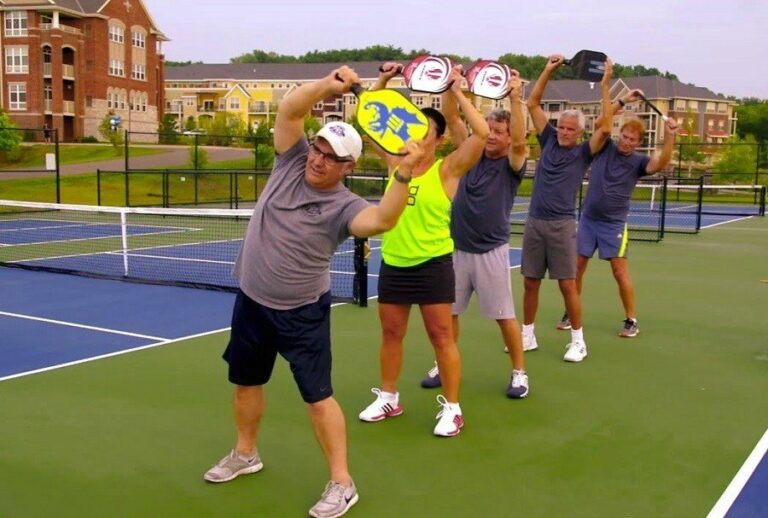
Importance of Warm-Up and Stretching
The significance of warm-up exercises and stretching routines cannot be overstated in preventing injuries. Consider warm-ups as the introductory chapter of a compelling novel; they set the stage for what’s to come.
- Injury Prevention: Engaging in proper warm-up exercises increases blood flow to muscles, enhances flexibility, and promotes mobility, helping prevent strains and sprains related to sudden movements.
- Performance Enhancement: A well-executed warm-up can improve coordination and reaction times, positively affecting gameplay and efficiency.
- Targeting Key Muscle Groups: Conducting a thorough stretching routine focuses on muscles heavily engaged during pickleball, such as shoulders, hips, wrists, and core. This constructive maintenance can reduce post-game stiffness.
- Specific Recommendations: Players should perform a warm-up lasting at least 5-10 minutes, integrating dynamic movements like arm circles, lunges, and leg swings to prepare for the demands of play.
Proper Equipment Selection
Using the right equipment is foundational for minimizing injury risks. Selecting suitable shoes and paddles tailored to specific personal needs is paramount.
- Proper Footwear: Investing in shoes designed specifically for court sports can provide support and prevent unwanted foot and ankle injuries.
- Equipment Fit: Selecting a paddle that matches the player’s grip size is crucial, especially for older individuals who may experience changes in hand strength selecting equipment that suits physical capacities is vital for long-term health.
- Avoiding Overuse: Players should avoid overexerting themselves during play taking breaks can help reduce the likelihood of injuries due to overuse. Starting slowly and building up intensity gradually is recommended.
- Protective Gear: While not mandatory, using braces or supports can provide added stability during play, offering essential protection for those with past injuries.
Technique Improvement
Players should work on continual improvement in their techniques to minimize injury risks such as sprains and strains:
- Learning Proper Mechanics: Taking lessons from experienced coaches or trainers can significantly enhance understanding of posture, grip, and movement.
- Consistent Warm-Ups: Engaging in a structured warm-up routine before games can prevent injuries and ensure better athletic performance.
- Cross-Training: Participating in other forms of exercise that promote flexibility, strength, and cardiovascular health can bolster overall fitness and resilience, which translates into better performance on the court.
- Listening to the Body: Heeding signs of fatigue or discomfort is critical; players should not push through pain to avoid exacerbating injuries a recognized body signal urging a break is essential.
Recovery and Treatment
Recovery from injuries is critical to resuming play in pickleball, and effective treatment is crucial for a successful return.
Initial Response to Injuries
Upon sustaining an injury, players should follow an immediate response protocol referred to as MICE (Movement, Ice, Compression, Elevation) within the first 24-48 hours post-injury, which emphasizes gentle movement alongside traditional methods of managing swelling and pain.
Rehabilitation Exercises
Specific rehabilitation exercises tailored to the type of injury are essential for effective recovery. For common pickleball injuries, these exercises may include:
- Wrist Exercises: Focus on wrist flexor and extensor stretches to build flexibility and strength.
- Achilles Tendon Injury Recovery: Implement eccentrics (heel drops) to promote healing efficiently.
- Elbow Rehabilitation: Employ wrist curls to build strength and alleviate discomfort.
- Shoulder Recovery: Exercises such as pendulum swings can restore movement and flexibility.
Players should consult with healthcare providers or physical therapists to define individualized rehabilitation plans that align with their specific conditions and goals.
When to Seek Professional Help
It is vital to recognize when to seek expert assistance for injuries. Signs indicating that medical evaluation is warranted include:
- Persistent Pain: Long-lasting pain that worsens with time, indicating potential chronic issues.
- Swelling or Inflammation: Persistent swelling that fails to improve in a few days should prompt a healthcare visit.
- Diminished Functionality: If difficulty in moving a limb or joint is noted, this may signify a more serious injury.
- Inability to Bear Weight: The inability to apply weight on an injured area necessitates prompt medical attention.
- Sensory Changes: Numbness or tingling sensations should not be overlooked; they may indicate nerve issues.
Recognizing these signs enables players to prioritize their health and seek timely assessments.
Long-Term Impact
Understanding the long-term implications of pickleball injuries is essential for players of all ages. Chronic injuries can lead to several other conditions post-injury if not managed appropriately.
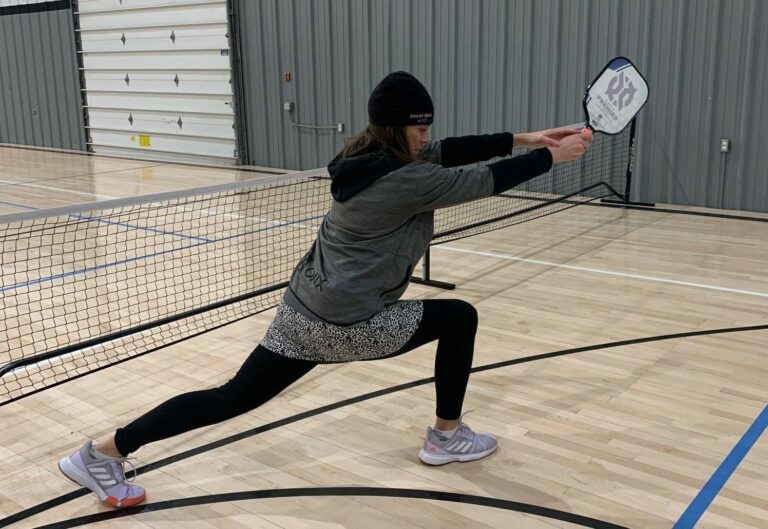
Chronic Conditions from Pickleball Injuries
Chronic conditions arising from pickleball injuries may include various issues, emphasizing the need for awareness and proactive management:
- Tendonitis: Chronic tendonitis due to overuse may significantly impact a player’s ability to participate.
- Chronic Lower Back Pain: Persistent lower back pain stemming from gameplay can affect overall quality of life and restrict mobility.
- Wrist and Hand Pain: Unaddressed wrist pain can develop into chronic issues, such as carpal tunnel syndrome.
- Recurrent Plantar Fasciitis: Continuous stress on feet can lead to plantar fasciitis, obstructing mobility.
The significance of monitoring these potential long-term impacts cannot be understated, as they may ultimately affect a player’s ability to engage in physical activity.
Strategies for Continuing Play After Injury
Players wishing to stay engaged in pickleball despite chronic conditions must adopt supportive strategies:
- Adhering to Proper Recovery Protocol: Following prescribed recovery protocols can bolster healing and prevent exacerbating injuries.
- Gradual Return to Play: Avoid rushing back into gameplay; players should gradually reintegrate themselves while monitoring any discomfort.
- Cross-Training: Engaging in alternative fitness activities can help maintain physical conditioning without aggravating injuries.
- Regular Check-Ins with Healthcare Providers: Maintaining open communications with healthcare professionals can help in effectively managing chronic conditions.
By employing these strategies, players can continue to experience the joy of playing pickleball while safeguarding their long-term health.
Managing Health as a Senior Player
For senior players, managing health through awareness of potential injury risks is essential. It is pivotal to focus on injury prevention, physical fitness, and effective management of existing chronic conditions.
Key Considerations:
- Understand Injury Types: Recognizing that older players are susceptible to specific injuries, such as fractures and sprains, aids in developing effective management strategies.
- Regular Conditioning: Develop conditioning routines that improve flexibility, strength, and balance critical components in preventing injuries as one ages.
- Emphasizing Warm-Up/Cool Down: Implementing thorough warm-up and cool-down routines helps prepare muscles and joints for activity, reducing the risk of injury.
- Monitoring Health: Regular health assessments ensure any underlying conditions are managed proactively.
- Utilizing Support Networks: Participating within community support can foster encouragement and motivation as players navigate physical challenges associated with aging.
In conclusion, being informed and proactive in recognizing injury risks, employing preventative measures, and understanding the long-term impacts of pickleball injuries ensures that all players, especially seniors, can fully enjoy the sport of pickleball while maintaining their health and vitality.
